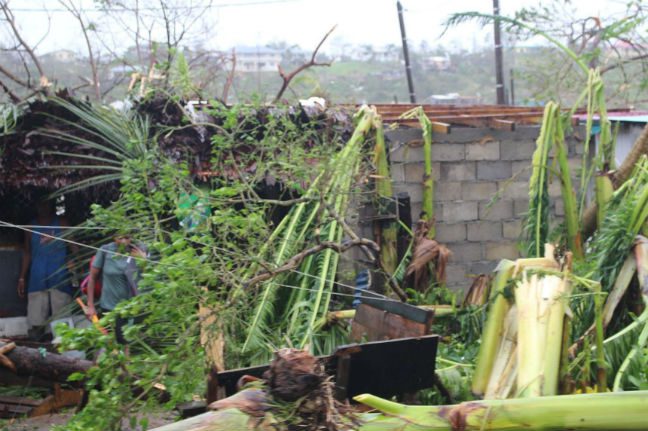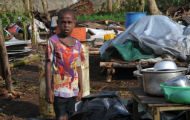
By Colin Collett van Rooyen, Country Director, Oxfam Vanuatu
It is crazy out there people. The world as we knew it in Vanuatu has gone. Pam took it with her.
It is a devastated world — broken to its physical core. Trees, some that must be hundreds of years old, are now stripped of their lush greenery — standing naked and embarrassed for the world to see — if they even stand any more. They are shredded, broken, pulverised. Whole clumps of them have slid down mountainsides together with the soil they that gave them life.
Buildings were lifted and dumped down somewhere else.
On the property I live on the roofs of two structures lifted, moved and landed elsewhere — one crushing a car as it did so.
On the property I live on the roofs of two structures lifted, moved and landed elsewhere — one crushing a car as it did so. Fragile structures made of wood and iron had no chance. Even less so for the traditional structures often made of woven palm fronds and light thatch, to let the cooling breeze through in the heat of Vanuatu’s ‘year round summer.’ They were never designed over thousands of years for a Category Five cyclone.
And so this mixture of twisted metal, ripped apart trees and an almost confetti-like layer of shredded greenery covered roads, pathways, houses, cars and people.
But out there too was something else. People —bleary eyed after a night of trauma — but working. Working hard in amazingly difficult conditions; hot, humid, rain, wind, tired, hungry, sore. Picking up the pieces of their lives, but more importantly helping to pick up the pieces of the lives of others.
Before I could even cut myself out of the tangle of trees and debris outside of my house, there were people outside ready with machetes, axes and their bare hands, doing it for and with me.
“How is your house?” we asked.
“Okay, but let’s clear a path so that you can get out and do the work that you need to do” was the response. A while later we sit down for a moment and talk more about their own house, a wood and metal structure located about five minutes from our place.
“It has gone” they said. “Gone? What do you mean?” It was exactly that. It had been broken, crushed and mangled by the winds while the family found fragile shelter in another structure alongside their home when things turned for the worse. And here they were helping us first.
So then down the road to work. A difficult journey with power lines, tortured sheets of metal and magnificent trees now strewn across the route; arranged in an obstacle course to challenge the toughest contestants of ‘Survivor’.
Their absolute resilience clear as crystal on what was otherwise a dark day. Muted smiles when any form of smile would be near impossible for most. Tears too, but hugs – tight embraces of personhood.
But more spectacular than the TV obstacle course, were the people. Their ‘get up, brush yourself off and make it better’ attitude shining through. Their absolute resilience clear as crystal on what was otherwise a dark day. Muted smiles when any form of smile would be near impossible for most. Tears too, but hugs – tight embraces of personhood. Being there and being with each other for each other.
It was and is magnificent — and is what Vanuatu means for me. It is about resilience in the face of extreme challenge. We in the international aid and development sector often think we can help people develop (and we can indeed do that), but we could learn more than a few lessons about that from the people of Vanuatu.
And the first lesson is to take their lead. To brush off the dust and debris, physically and emotionally, and start working towards a coordinated, Ni-Vanuatu led response that takes all the lessons we can find from the people of Vanuatu about how to be resilient — now and later.
You can help support Oxfam’s response to Cyclone Pam. Please give generously.
